skip to main |
skip to sidebar
With a reasonable weather forecast for Saturday, 17th November 2018, I decided to repeat the day trip to Liverpool which I occasionally make. Public transport in my area is now more restricted, so the possibility of bus to Penkridge to catch the train (as described in the post here) no longer exists. Instead, I presented myself at the bus stop for the first service to Wolverhampton, due at 08:35. I'd hoped that, if it ran to time, that might allow me to catch the 09:20 'London Northwestern Railway' service to Liverpool. When the bus arrived over ten minutes late, I resigned myself to a later departure from Wolverhampton but the bus made good time and, after getting off in Stafford Street a brisk walk to the station made me more optimistic about catching the 09:20.
Railway Drive has been blocked to vehicles for some time as the 'Midland Metro' at last constructs its extension from the present inconvenient St. George's terminus in Bilston Street to the railway station. A light rail system for the West Midlands was mooted in the 1960s but it was 1981 before serious studies were made and 1999 before trams on a single route from Wolverhampton to Birmingham Snow Hill started running. In my 2016 post Grand Central and Birmingham New Street Station I described progress on the extension at the Birmingham end to Birmingham New Street station and that is now in use. As I hustled to the station, I could see that track laying (using inset track) had started in Railway Drive - a mere 20 years after the opening of the light rail system.
Although the 09:20 was on time, I was able to catch it after all and I would have enjoyed the ride apart from a 'Hen Party' of a dozen ladies and one man who noisily crowded into my coach with their plastic wine glasses, a large bottle of prosecco and various mixers, celebrating a birthday (I couldn't determine whose) in a particularly noisy fashion which continued unabated until our arrival in Liverpool.
We stopped in platform 11 at Crewe, as usual, and I admired the polychrome brickwork I'd commented on in an earlier post here. There's a brief description of Crewe and the architecture of its station in the post Crewe Station.
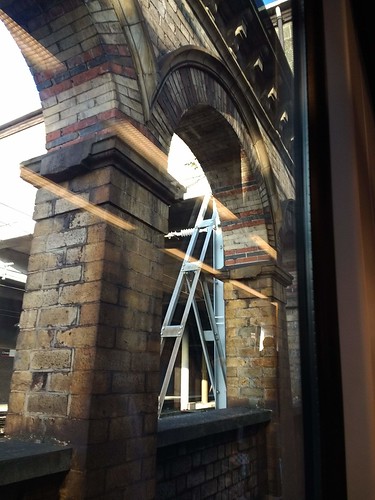
Crewe Station 17-Nov-2018: A close-up of the polychrome brick supporting wall flanking platform 11 (apologies for the reflection of the carriage lighting).
As we continued to Liverpool, we passed considerable re-signalling work in progress. I couldn't determine the present extent but some new colour light signals were in use, with the control code 'WE' and 4-digit signal numbers so I concluded that at least part of the line has now transferred control to the Manchester Rail Operating Centre. I still have trouble grasping that we'll end up with just 14 such Operating Centres in the country (Derby, Gillingham, Cardiff, Saltley, Edinburgh, Ashford, Didcot, Glasgow, Three Bridges, Manchester, Romford, York, Basingstoke, Rugby). Halton Junction signal box seemed to have gone and the Air Raid Precautions signal box structure at Runcorn had the windows papered over so presumably is no longer operating. Ditton Junction, Speke Junction and Allerton Junction appeared to be still in use but no doubt their days are numbered. We swept past Edge Hill signal box and descended through Edge Hill Cutting where new signals were in evidence. Lime Street station re-opened in July 2018 following a period of complete closure allowing the modernisation work to be completed. There's more information about the work undertaken in a 2016 article from Rail Engineer here.
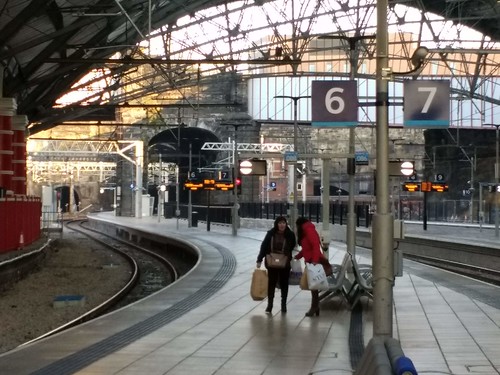
Liverpool Lime Street Station, 17-Nov-2018
I purchased a 'Saveaway' ticket allowing travel on buses, trains and ferries within Merseyside that day and descended by a series of escalators to the underground 'Mersdeyrail' platform at Lime Street Station. The first train took me two stations to James Street, where one of a series of lifts returned me to street level. It wasn't too warm but the sun was shining brightly so it was a pleasant walk to the Waterfront. I judged I'd not have time to catch the 11.00 a.m. Mersey Ferry, so I watched 'Royal Iris of the Mersey' slip way from Pierhead before entering the Museum of Liverpool where I checked that the star exhibit, the locomotive 'Lion', was still safe. I walked around the outside of the Museum to take a photograph of the Old Pilotage Building.
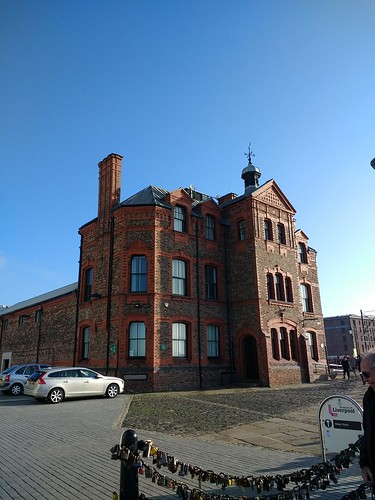
Liverpool, 17-Nov-2018: The Old Pilotage Building.
Next to the Old Pilotage, I found a massive display of 'Love Locks'. There's an article on this phenomenon here.
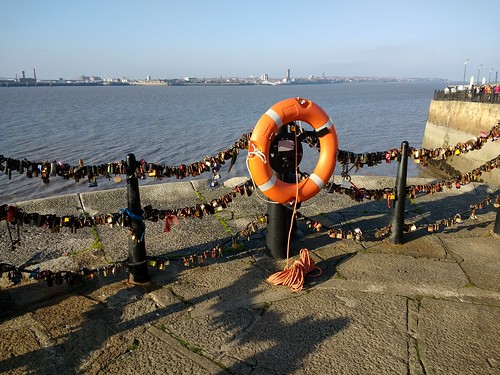
Liverpool, 17-Nov-2018: 'Love locks' overlooking the Mersey.
The clocks on the Liver Building were once again working and my picture shows the bright sun and blue sky on the day.
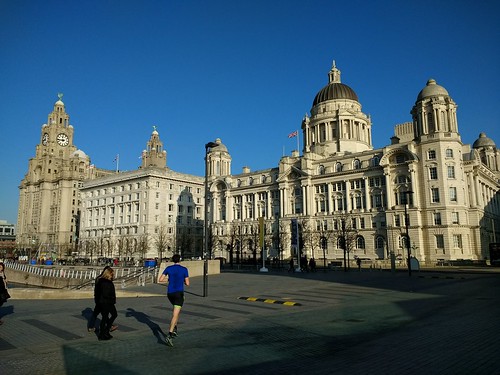
The 'Three Graces'.
It's become a tradition that I take the Mersey Ferry when in Liverpool, so I boarded the ferry which left at noon. Once we set off, the wind on the river was quite fierce, but with jacket zipped-up and gloves on, I was fine. The ferry first heads downstream on the Liverpool side whilst the pre-recorded commentary describes the north docks. We passed a number of small motor vessels moored with groups of men rod fishing. A large vessel was approaching us mid-stream and, as it came closer, I identified the passenger/car ferry 'Ben-My-Chree' returning from Douglas, Isle of Man. Once she'd passed us, our ferry turned to port to cross behind 'Ben-My-Chree' and head back upstream on the Birkenhead side. As we crossed through the wake of the larger ship, there was a fair amount of pitching. We berthed at Seacombe Landing stage with another vessel already moored.
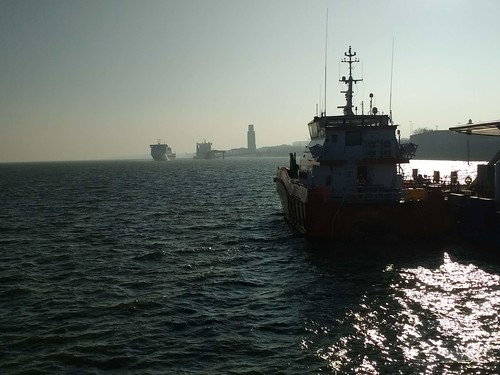
Liverpool, 17-Nov-2018: View from Mersey Ferry 'Royal Iris of the Mersey' approaching Seacombe Landing Stage with catamaran Njord Magni already moored at the south end. In the background, 'Ben-My-Chree' is berthing at Twelve Quays.
After passengers had alighted and boarded at Seacombe, we set off upstream past the moored vessel - crew transfer vessel 'Njord Magni', one of the high-speed catamarans which services the various offshore windfarms established in the Irish Sea. We passed the northern berth at Twelve Quays whilst 'Ben-My-Chree' was still docking. The southern berth was occupied by 'Stena Forerunner', which I don't believe I've seen before, apparently currently operating the Belfast service.
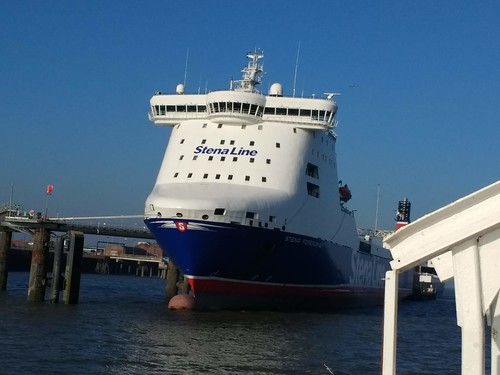
Liverpool, 17-Nov-2018: Twelve Quays, with 'Stena Forerunner'.
We docked at Birkenhead Woodside Landing Stage, where I left the ferry before it completed its triangular cruise by sailing back to Pierhead, in time to form the next departure from Liverpool Waterfront at 1.00 p.m.
I made the usual walk to Hamilton Square Merseyrail station and descended to the underground concourse serving the three platforms using one of the series of electric lifts. After a few minutes wait, I boarded the next train to New Brighton. New Brighton's Victoria Road led me to the Old Town, where I purchased a fish cake and chips which I ate as I walked to the Marine Promenade. I sat in one of the delightful Victorian shelters to finish my meal. The bright sun had encouraged lots of people to 'take the air' and there was quite a holiday atmosphere. I decided to patronise the ice cream van selling soft ice creams before continuing west. I passed Fort Perch Rock but decided to defer my visit to the weekend museum based there. Their website is here. I continued past the Marine Lake, admiring the decommissioned New Brighton Lighthouse (a Grade II* listed building) and entered King's Parade, with its modern shopping centre on my right and New Brighton Lifeboat Station, where they operate a rigid inflatable inshore lifeboat (a 'B' class 'Atlantic'). Then I turned left into Atherton Street to return to the railway station, noting that the local signage seems to have adopted the dreadful modern importation 'Train Station'. A stiff climb took me back to the attractive, welcoming and warm Merseyrail station and, somewhat exhausted, I thankfully took my seat on the waiting 3-coach train.
This time, I stayed on the train all the way to Liverpool Lime Street, noting that the journey between Hamilton Square and James Street stations had taken just over five minutes - considerably quickly than my enjoyable surface journey in the opposite direction a few hours earlier! A Birmingham service was already in platform 7 and I was happy to take this train back to Wolverhampton after a pleasant, if short, trip to Merseyside.
Related posts on this website
To view all my posts on Merseyside, click here or, alternately, select label 'Merseyside'. Posts are displayed in reverse date-of-posting order.
My pictures
This album includes pictures taken during this trip:-
Liverpool.
Ty Gwyn is a small commercial woodland in north Wales extending to about 27 hectares (66 acres). In 2009-2010, around half of the plantation was harvested. This area was replanted with Sitka spruce and mixed broadleaves during 2010. In 2015, a further 10 hectares were felled and replanted, again with Sitka spruce and mixed broadleaves. The balance of the woodland has not been felled but has been left to continue growing.
I made an inspection visit to Ty Gwyn on 21st November 2018 with David Adam of Fountains Forestry who manage the site. In 2016, Fountains Forestry became part of F & W Forestry Services based in Georgia, USA. The weather was overcast and quite cold. Access is via a single gate and a system of internal forest roads gives access throughout the plantation for timber lorries and similar vehicles. The southern road leads on a heading somewhat south of westerly from the gate on the eastern boundary to just short of the western site boundary. A little over halfway along the southern road, a junction leads to a short link road connecting to the northern road which runs more-or-less parallel to the southern road from just short of the western site boundary to the Pool in the east.
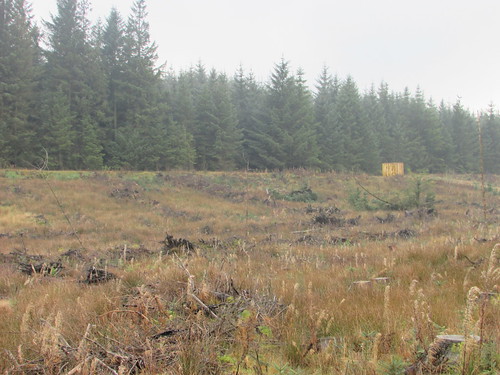
Ty Gwyn 2018: View from northern road looking south, with 2015 planting in the foreground and the unfelled compartment in the background.
We conducted our inspection on foot, mainly using the forest roads. Shortly after we started, we experienced sleet which, fortunately, only lasted a few minutes. Later, the sun tried to break through but it remained a poor day for photography.
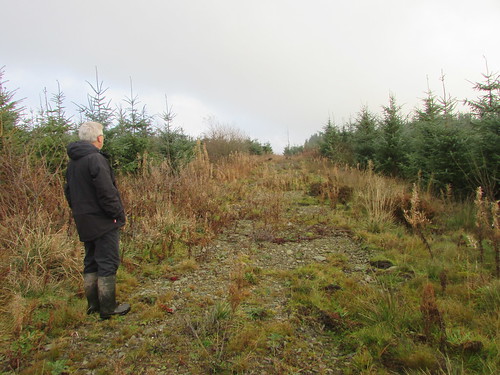
Ty Gwyn 2018: David Adam looking east on northern road.
The 2010 planting impressed me with its growth in eight years.

Ty Gwyn 2018: 8-year old growth near the northern boundary.
The appearance of the Pool was much improved following maintenance work.
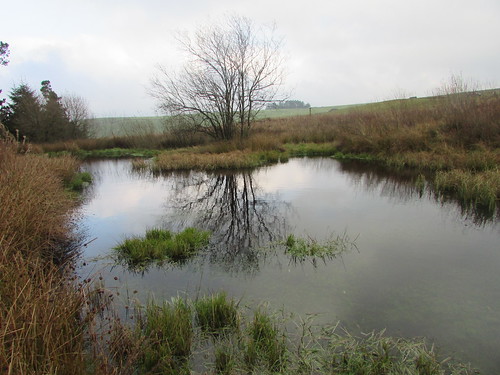
Ty Gwyn 2018: The Pool, looking east.
David confirmed that the progress of the 2015 planting was perfectly satisfactory although some maintenance work would probably be needed in Spring 2019.
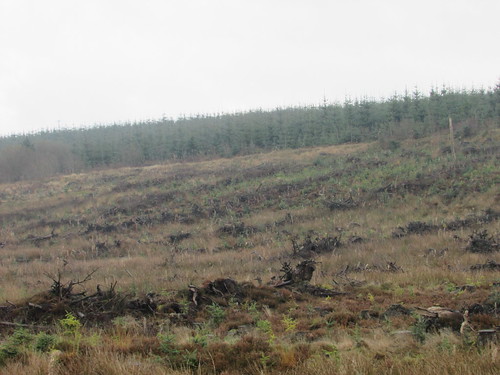
Ty Gwyn 2018: View from northern road looking south, with 2015 planting in the foreground and 2010 panting in the rear.
My posts about Ty Gwyn
You can find all my posts about Ty Gwyn here, with links to albums of pictures.
Pictures of Ty Gwyn
Ty Gwyn 2018.
You can find all my collections of pictures of Ty Gwyn here.
The Battlefield Line held a Steam Gala on the weekend of 13th and 14th October, 2018. Three locomotives were in steam - 'Light Prairie' 5542 (which had performed excellent work on the steam services throughout 2018) 'Pannier' 6412 (expected to remain until Christmas 2018) and veteran 6-coupled saddletank 813.
A little history
The Shackerstone Railway Society was set up in 1969 and early passenger operations took place on a single-line between Shackerstone and Market Bosworth, using the original signal box at Market Bosworth to control a run-round loop at Market Bosworth. In 1992, the single-line was extended to Shenton (the re-opening is mentioned in my post here). The signal box at Market Bosworth was taken out of use and all the semaphore running signals were placed at 'clear' with a view to re-commissioning the signal box at a later date. The Single Line Train Staff which allowed one train onto the Shackerstone-Shenton single line was arranged as a 'Split-Staff' with two halves screwed together to facilitate re-opening Market Bosworth as a Block Post later with two single line sections (Shackerstone-Market Bosworth and Market Bosworth-Shenton) but, until the 2018 Gala, drivers have always had to have both halves of the Train Staff in their possession before setting off.
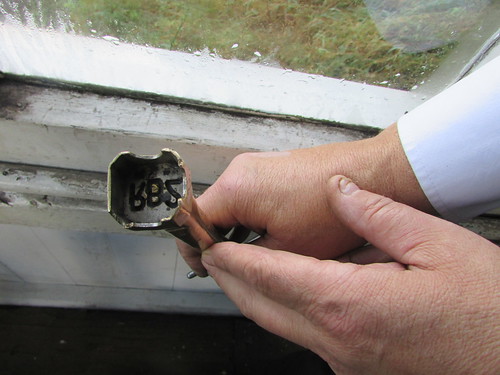
The complete Shackerstone-Shenton Single Line Staff, showing the 'Castell Key' used to release the Starting Signal (nowadays termed 'Section Signal') at Shackerstone.
In 1998, when the 125th Anniversary Celebrations of the Ashby and Nuneaton Joint Railway were held, Shenton Station Working was introduced where an engine was allowed to lay-by in the loop at Shenton ready to take the next arriving train back to Shackerstone, under the control of a Person in Charge at Shenton but I don't think that arrangement has been used for some time.
Train Staff Working
On a double-track railway where each line is used in one direction only (in the UK 'left-hand running' is usual) the biggest risk is a train running into the rear of an unexpectedly-halted previous train. The 'space interval' or Absolute Block system was introduced to address this danger.
But single-line railways needed a different approach from the start as there was not only the danger of one train catching up with another but the possibility of trains travelling in opposite directions meeting head-on. The evocative American phrase for this situation is 'cornfield meet'. In the U.K. the system of a 'Train Staff' was adopted. This was often a rounded length of wood (hence the name 'staff'). There was only one Train Staff for each single line section, marked with the section of line to which it applied. Before entering a single line, the driver took possession of the unique Train Staff and was thus assured that no other train was occupying the section. On clearing the single line, the driver would surrender the staff to the signalman or person in charge, allowing another train to enter the single line. Provided drivers were in possession of the Train Staff when on the Single Line, this simple system was safe.
To increase the capacity of the line, a long single line could be divided into separate sections by intermediate stations often provided with passing loops. There was only one Train Staff for each single line section, marked with the names of the two stations between which it applied. Again, provided the footplate crew made certain they were carrying the correct staff for the section, the system remained safe. Train Staffs could be distinctively painted or shaped to assist the driver and fireman in identifying the correct staff but enginemen were also expected to read the names of the stations marked on the staff as a cross check. When I was a trainee fireman in preservation, I was taught to collect the Train Staff from the Signalman (or person in charge), check the details, shout "Correct Staff!" then display it to my Driver so that he could independently satisfy himself that we had proper authority to enter the single line section.
This simple system was safe but inflexible. If trains alternated in direction on the single line, the first train carried the staff from station A to station B, the second train, in the opposite direction, returned it from station B to station A. But there was no way for a second train from A to B to follow the first whilst the Staff remained at station B. There are many tales of junior porters having to carry the Staff to the opposite end of the single line by bicycle.
Train Staff and Ticket Working
Train Staff and Ticket Working seeks to address the inflexibility of ordinary Train Staff Working. The signalman or Person in Charge at station A must be in possession of the Train Staff before allowing a train into the single line section.
If a second train will run in the opposite direction, the Train Staff is actually CARRIED by the driver of the first train so as to be available for the second train on arrival at station B.
If a second train will follow the first in the same direction, the driver of the first train must be SHOWN the Staff. Seeing the Staff gives assurance that another train has not entered the opposite end of the section. The signalman also issues a numbered paper Ticket to the driver, identifying the specific train and giving authority to pass through the single line. When the train arrives at station B, the ticket is surrendered to the Signalman or Person in Charge there who cancels the Ticket. Because the Train Staff is still at station A, a second train may follow, this time with the driver CARRYING the Staff (unless a further Ticket is issued because of a third train in the same direction).
With Staff and Ticket working, telephone communication between the Signalmen or Persons in Charge at either end of the single line is essential because a further Ticket must not be issued until any previous Ticket had been correctly received and cancelled. Before allowing a train onto the single line, the Signalmen or Persons in Charge at both ends must agree upon the direction of the NEXT train required to pass over the single line. Whether a driver receives the Staff or is shown the Staff and receives a Ticket depends upon the direction of the NEXT train through the section. If the next working is in the opposite direction, the Staff is carried to the other end so it can be given or shown to that train. If the next working is in the same direction, the driver is shown the Staff (so that it can be shown to or carried by the following train) and CARRIES the Ticket. Tickets are valid for one specific train and, after a single use, are cancelled by the Signalman or Person in Charge receiving the used ticket.
Introduction of Train Staff and Ticket Working for the 2018 Gala
By dividing the Battlefield Line into two Single Line Block Sections (Shackerstone-Market Bosworth and Market Bosworth-Shenton), it's possible to have a more intensive service, although trains in opposite direction cannot yet pass at Market Bosworth. Following modern British signalling practice, 'Distant' boards have been erected approaching Market Bosworth in both directions, followed by 'Stop' boards nearer the station. Trains are 'called by' the 'Stop' boards by a yellow flag displayed from the platform by the Person in Charge. Leaving Market Bosworth in both directions, further 'Stop' boards are provided, reminding drivers that they require the appropriate Train Staff or Ticket and permission from the Person in Charge before proceeding. All these arrangements had been designed by John W. who was also Person in Charge at Market Bosworth on both days of the Gala and had established a 'Train Control Office' at one end of the museum building on Market Bosworth platform which he had equipped with a Train Control Board giving a graphical display of trains as a reminder. Actual timings of all movements were recorded, just as the Signalman at Shackerstone recorded all movements in his Train Register Book. There's an introduction to the Train Register Book here.
A new passing loop at Market Bosworth is currently under construction which, when completed, will allow trains to pass one another.
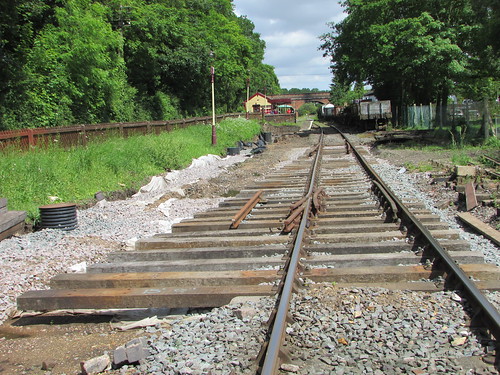
Market Bosworth View from foot crossing looking towards Shackerstone showing the station and work in progress on the new passing loop.
In addition, the 'platform siding' through the station is to be controlled by Annett's Key from a 2-lever ground frame being installed at the north end of the station and this would also enable a train to 'lay-by' and be passed by another train.

Market Bosworth, October 2018: The 2-lever Ground Frame which, on completion, will control access to the platform siding.
With neither the loop nor the siding available for the Gala, operations were more limited but the use of Train Staff and Ticket working allowed the main train to leave Shackerstone for Shenton and, once it had cleared Market Bosworth, for another train (usually the 'Auto train') to leave Shackerstone and follow as far as Market Bosworth. The 'Auto train' could then return to Shackerstone and, once the 'Auto train' was clear of Market Bosworth, the main train could return from Shenton as far as Market Bosworth. Once the 'Auto train' had arrived back at Shackerstone, the main train could complete its run back to Shackerstone.
Whether a driver receives the Staff or is shown the Staff and receives a Ticket depends upon the direction of the NEXT train through the section. If the next working is in the opposite direction, the Staff is carried to the other end so it can be given or shown to that train. If the next working is in the same direction, the driver is shown the Staff (so that it can be shown to or carried by the following train) and CARRIES the Ticket. Tickets are valid for one specific train and, after a single use, are cancelled by the Signalman or Person in Charge receiving the ticket. Close co-operation between the Signalman at Shackerstone and the Person in Charge at Market Bosworth is clearly essential.
Events of 13th October 2018
I was rostered to drive 813 with Jamie W. initially firing until he was relieved by Rod T. later in the morning. Locomotive 813 had previously visited the railway back in 2007 and I'd been impressed then with what a lively, willing engine she was. There's a brief report on that visit here.
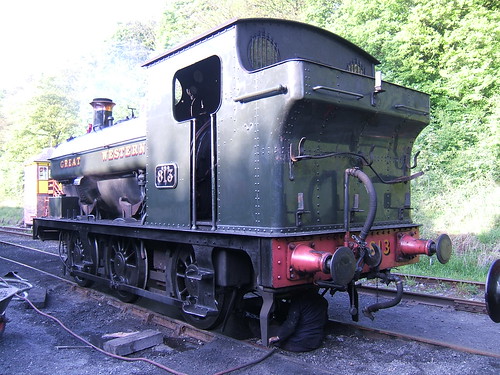
Locomotive 813 outside Shackerstone shed in 2007.
Our first working of the day was the demonstration freight train to Shenton, due to depart Shackerstone at 08:00. Jamie and I were delighted that Adrian L. had agreed to light-up and start oiling round, making a much easier start for us both. In the days of steam on the 'Big Railways', 'P and D' ('Prep and Dispose') turns were commonplace where a driver and fireman would spend the whole shift in and around the locomotive shed either preparing engines to go out (steam-raising and oiling-round) or 'putting to bed' incoming engines (coaling, watering and either cleaning the fire or withdrawing it, depending upon the engine's next duty). In preservation, having Preparation or Disposal done for you is unusual.
I had intended to complete the oiling-round myself but the new system of working, with the line divided into two single line sections (Shackerstone-Market Bosworth and Market Bosworth-Shenton) was being introduced that day and by the time I'd attended the induction meeting held by John W. for all the loco. crews and signed to confirm that I understood the arrangements for Train Staff and Ticket Working, Adrian had completed the oiling.
In the post Santa Specials at the Battlefield Line 2017 I commented "The rather cramped track layout at Shackerstone requires careful choreography to manage two trains". For the Gala, we had three locomotives and three trains - 4-coach passenger, 1-coach passenger ('Auto train') and Freight train so the moves had to be well-planned by the Director of Operations.

Shackerstone track diagram. North is to the left on this sketch.
Click on diagram for uncropped view.
The loco shed at Shackerstone is a 'straight shed' and, from the main door, the locos had been stabled in the order 6412, 813 and 5542. So we had to wait for 6412 to move forward into platform 1 and set back into the DMU Siding adjacent to the shed where the Great Western 'Auto' coach was stabled before we could come 'off shed' and couple onto our freight train waiting in platform 1. The train make-up was:-
Box Van
Long wheelbase tool van
LMS Hand crane
Match wagon
LNER Brake van
The Hand crane and Brake Van are recent arrivals from the now-closed Electric Railway Museum in Coventry.
With Carl M. as Guard on the brake van, we set off. We were due to be back at Shackerstone before the first passenger working so, as expected, we were issued with the 'half-staff' authorising movement to the 'Stop' board approaching Market Bosworth.
Working loose-coupled freight trains requires some care since there is always slack in the couplings and, apart from the Guard's screw handbrake, only the locomotive has a working brake but with such a light train I didn't anticipate problems and there were none. Although the morning was still rather damp, we passed a number of photographers before slowing for the new 'Stop' board approaching Market Bosworth. Spotting a yellow flag displayed from the station platform, I gave a 'pip' on the whistle in thanks and kept the train rolling into the platform. I surrendered the Shackerstone-Market Bosworth 'half-staff' to John W. and was issued with the other 'half-staff' authorising movement between Market Bosworth and Shenton. This half of the staff includes an Annett's Key which would allow us the unlock the Ground Frame at Shenton. John W. also gave permission for us to pass the 'Stop' board so we continued our pleasant run to Shenton.
I'm afraid we don't often have the chance to run demonstration freight trains at the Battlefield Line. I think my last freight at Shackerstone was during the 2015 Gala, described here. On that occasion, the freight was 'double-braked', with a brake van on each end, so running round at Shenton was similar to running round a passenger train. But in 2018, we only had one brake van so we had to move it to the other end of the train before returned to Shackerstone. My earlier report on the 2015 Gala mentioned a favourite question posed to trainee shunters:-
Simple loop at end of a branch: one engine, set of wagons, one brake van arrives. What are the moves to run round and go back?
The arriving train stops with the brake van just outside the loop points. Van brake is applied and brake van is uncoupled. Engine draws wagons into line 1 and sufficient wagon handbrakes are applied before engine uncouples, draws forward to headshunt, reverses round line 2 to the brake van, attaches it and takes it forward round line 2 to the headshunt, then propels the brake van onto the waiting wagons. Brake van is attached to wagons, brakes set as required, engine uncouples, forward into headshunt, reverse around line 2 until outside the loop points which are then set towards the wagons. Finally, engine moves forward onto the wagons and couples. Job done!
So, on arrival at Shenton, that's what we did. After detaching the brake van, we drew the wagons just clear of the loop points leaving most of the train outside the platform. This was the first proper run these wagons had been on in some time so, although they'd all been previously got ready for their excursion, Carl and I agreed it was prudent to examine both sides of the train and check for any overheating in the axleboxes before returning. Everything was (literally) 'cool', so we completed the moves, using the 'half-staff' to release the ground frame controlling the loop points. Carl obtained permission from Market Bosworth Train Control to return and, with the 'half-staff' back on the engine, we set off bunker-first.
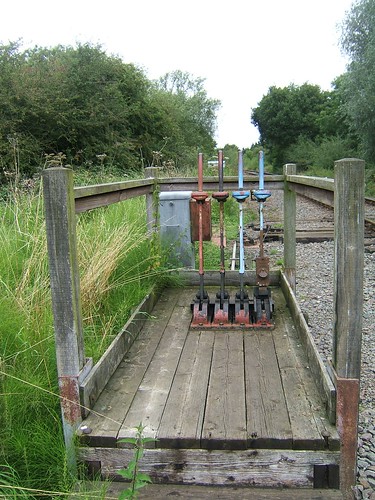
Shenton Ground frame. The 4-lever frame is released by inserting the Train Staff into the lock near the bottom of the rightmost lever.
Approaching the new 'Stop' board at Market Bosworth, I whistled to announce our arrival and received a yellow flag from the platform, which I acknowledged with a 'pip'. In the platform, John W. received the Market Bosworth-Shenton staff, issued the Shackerstone-Market Bosworth staff and gave permission to pass the new 'Stop' board leaving Market Bosworth. We set off for a gentle romp home, again passing a few photographers.
At Shackerstone, the tall lattice post home signal (No. 2) came 'off', the lower disc ground signal outside the box (No. 3) came 'off' as we approached, we surrendered the Train Staff to the signalman waiting on the landing outside the box and brought our train to a gentle stop short of the 4-coach main train standing in platform 2. When a main running signal (like No. 2) is off, the driver is assured that the line is clear at least up to the next signal, but a ground signal 'off' only authorises movements "as far as the line is clear" towards the next signal. We'd had a great trip but, following a late start, we were still about 15 minutes late arriving.

Shackerstone Signal Box, showing the 2-disc ground signal controlling movements into platform 1 (top disc) or platform 2 (bottom disc).
The next move was the first single-coach 'Auto Train' to Market Bosworth, with 'Pannier' 6412 propelling the coach with the driver, Adrian A., controlling the train from the driving compartment in the 'Auto trailer'. Numerous people watched expectantly as the 'Auto' eventually left at 09:20, 20 minutes 'down'.

Battlefield Line Steam Gala 2018: 813 simmers after the freight train run and the 'peg' is off for the first 'Auto Train' of the day. 5542 waits to come off shed.

Battlefield Line Steam Gala 2018: The first 'Auto Train' leaves Shackerstone.
Once the 'Auto Train' had left, there was a period of furious activity as the freight train was stabled in the DMU Siding alongside the shed, out of the way, and 5542 moved onto the coaches in platform 2 before the 'Auto Train' returned.

Battlefield Line Steam Gala 2018: The first 'Auto Train' arriving back at Shackerstone.
After 5542 had left with the late-running 09:30 to Shenton, Shackerstone became quiet again. The timetable called for 5542 to complete its round trip, after which the 'Auto Train' was scheduled to make its second trip to Market Bosworth at 10:30. At that point, we were still about 20 minutes adrift.

Battlefield Line Steam Gala 2018: The second 'Auto train' leaves Shackerstone, viewed from 813 standing on the DMU siding.
With the 'Auto train' away, I was able to shunt 813 across to platform 2 and attach to the 4-coach train for our first passenger working. Once the 'Auto' was back, we were able to leave. It should have been 11:00, but we were still about 17 minutes late.
This time, the 'Auto' was to follow us after we'd reached Market Bosworth, so I was shown the Train Staff and issued with Train Staff Ticket No. 1, issued to train 1S02 (the second Shenton train). I placed the ticket on the shelf at the back of the cab, with two empty pottery mugs as paperweights.

Battlefield Line Steam Gala 2018: Leaving Shackerstone with 813 on the late-running 11:00 train.
All went well until we were past the photographers near Headley's Crossing when a sudden, strong cross-wind whipped everything off the shelf at the back of the cab. A plastic cup of tea I was about to sample emptied itself in Jamie's direction and, when I checked, Train Staff Ticket No. 1 had disappeared. We continued to Bosworth and I sheepishly admitted my failure to John W., offering a fuzzy photograph of the missing item as a substitute. I resolved to thereafter carry Tickets in a pocket, for safety.

Battlefield Line Steam Gala 2018: Train Staff Ticket No. 1
We were issued to the Market Bosworth-Shenton train staff, were given permission to proceed and completed our run to Shenton without further incident. We ran round our four coaches, ready for the return run. All went to plan to Market Bosworth. In the platform, I surrendered the Market Bosworth-Shenton staff and John W. issued the Shackerstone-Market Bosworth staff, also giving us permission to pass the new 'Stop' board leaving Market Bosworth. Once all the passengers had sorted themselves out, we received the 'Right Away' from the Guard and set off up the bank.
On a standard Great Western engine, the vacuum ejector would normally be used only until the speed had reached 15 m.p.h. since the vacuum pump could then be relied upon to maintain the required 25 in/Hg (inches of mercury) partial vacuum in the train pipe until the next brake application was made. But 813, being a 'Swindonised' Hudswell Clarke, lacks a vacuum pump so the vacuum ejector must be used as required.
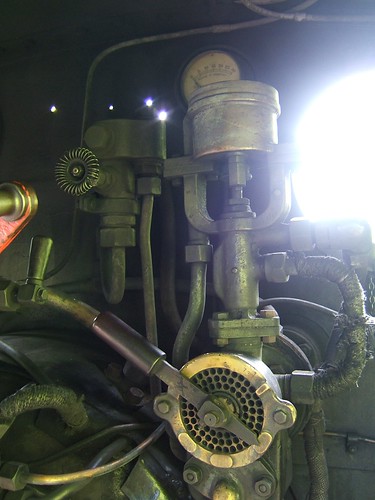
The Great Western combination steam/vacuum brake application valve fitted to 813 (shown in 'Fully Applied' position).
It became clear that 813 had gone 'off the boil'. Performance deteriorated as the boiler pressure fell and then the ejector had difficuly maintaining the vacuum. Speed dropped further as the train brakes started to drag, despite Jamie's attention to the fire. Shortly after Headley's Crossing, it was obvious we'd have to 'stop for a blow up' so we came to a gentle stop and applied the handbrake. Carl M. descended to the track and we agreed to 'pull the strings' on the train, which would allow to us to complete the journey to Shackerstone with a slightly lower partial vacuum above the brake pistons, if the boiler remained reluctant to steam. Carl and I made sure all eight brake pistons on the train were fully 'down', releasing the coach brakes, by which time matters on the footplate looked far healthier. Having lost a few more minutes, we were then able to finish the journey back to Shackerstone.
5542, attached to the freight, was waiting for us to arrive so that the delayed noon freight train could set off. Once the freight had passed Market Bosworth, 6412 followed with the fourth 'Auto train' of the day to our middle station and back. Meanwhile, 813 was run round, watered and made ready to work the third passenger service of the day to Shenton. By this time, Rod had relieved Jamie as fireman and I explained the problems we'd had with the brakes on the previous trip.
I'm not sure how late we were departing by the time 5542 returned with the freight but, once we were clear of the restrictions up to Barton Road Bridge, I gave 813 full First Valve, well linked-up, and she ran like the proverbial sewing machine. There's a very short restriction to 10 m.p.h. near the Water Works but, once past this, we ran down the bank past Airport Bridge in fine style. I braked, prepared to stop at the new 'Stop' board but John W. gave us a yellow flag so I was able to keep the train moving into the platform at Market Bosworth. I extracted the folded-up Ticket from my overall pocket and delivered it to John who gave me permission to proceed and the Market Bosworth-Shenton Train Staff. Having observed the speed restriction leaving the station and across the underbridge near Deer Park Siding, I was able to open-out 813 a little and we made an excellent run, finally slowing for the 5 m.p.h. 'slack' near the Ambion Lane underbridge and the approach to Shenton Station. The weather was now dry, the sun had appeared and there were lots of visitors admiring 813 as we ran-round the train. Rod kept the boiler 'up to the mark' so we enjoyed an excellent run back to Shackerstone.
5542 had disposed of the freight train and was ready to 'hook-on' to the south end of the main train to work the delayed two o'clock departure to Shenton. As usual, once 5542 had left Market Bosworth, the 'Auto train' made another trip to 'Bosworth and Back'. But, this time, when 5542 returned from Shenton with the 4-coach main set, rather than the 4-coach train forming the next train to Shenton (the late-running three o'clock), this time the 'Auto train' was to go all the way to Shenton. With 5542 on the south end of the 4-coach train and 813 on the north end, the idea was that the 'top-and-tailed' main set would follow to Market Bosworth and back for variety.
The sight feed lubricator on 813 chose that inopportune moment to "throw a wobbly" (having worked perfectly until then). It shouldn't have been empty, but we drained the lubricator, refilled it with the specified 680 SAE compound steam oil and attempted to restart it. I failed: Rod, Adrian and Carl failed so the Director of Operations decided to cancel the 'top and tail' working. Unfortunately, by this time, the 'Auto train' had already left, carrying a Ticket, in expectation of the 'top and tail' working following to Market Bosworth with the Train Staff. So, (shades of the junior porter story mentioned earlier), a Volunteer who was just about to leave for the day was asked if "he wouldn't mind just dropping off the Train Staff at Market Bosworth on the way". By this method, the 'Auto train' was finally able to return to Shackerstone but the four o'clock service to Shenton, hauled by 5542 was now quite late, so the five o'clock service, which should have been 813's last train was cancelled. 813 was coaled, watered and assisted with the re-marshalling of the freight train ready for the following morning. I then handed over the locomotive and booked off since I would be back again the following day (on 5542). 813 would be the last locomotive into the shed on Saturday evening because it was the first engine required the next day.
Not all the arrangements for the ambitious timetable had worked but I'd had an enjoyable day, as I hope did the other Volunteers and our visitors.
Lubricating the steam circuit in locomotives
Moving parts in contact with steam (such as the valves, pistons and regulator valve) require lubrication. 813 is provided with oil cups on the front of the cylinders, accessed by opening the hinged 'piano front' under the smokebox door.
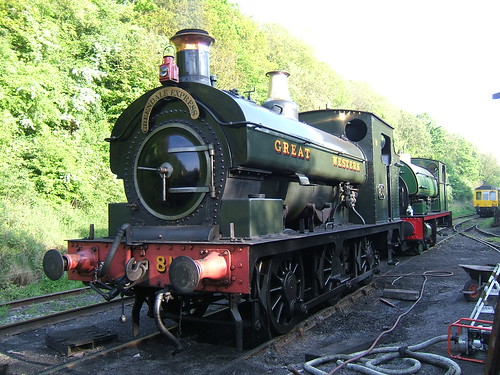
813 stands in front of Shackerstone resident 'Sir Gomer' in 2007. 813's hinged 'piano-front' can be seen under the smokebox door, with a single, central knob.
On early locomotives, one 'dose' of oil to this type of cylinder oil cup during preparation, possibly repeated later, would frequently be the only oil supplied to the steam circuit. With lower boiler pressures and saturated steam, the entrained moisture in the steam could be quite an effective lubricant. The introduction of higher-temperature steam, especially when 'Superheating' was used, required better compound steam oils which could retain their properties at higher temperatures and a more consistent method of feeding the oil. For a long time, the Sight Feed Lubricator provided the required reliability of oil feed until the use of mechanical lubricators became widespread. Even non-superheated locomotives (like 813) could benefit from the installation of a Sight Feed Lubricator and 813 has one, mounted in front of the driver. Although private locomotive builders started to fit sight feeds where specified, I suspect the one on 813 is a Swindon modification as it appears to employ some parts used elsewhere by Swindon.

GWR loco 813, October 2018 The Sight Feed Lubricator.
Related posts on this website
Battlefield Line Steam Gala 2018 (Part 2)
The last Steam Gala at the Battlefield Line was in 2015 and my report on that event is here.
Locomotive 813 previously visited the railway back in 2007 and my report on that visit is here.
To see all my posts about the Battlefield Line, select Label 'Battlefield Line' or click here.
My photograph albums
Where necessary, clicking on an image above will display an 'uncropped' view or, alternately, pictures may be selected, viewed or downloaded, in various sizes, from the albums listed:-
5542 GWR Locomotive
813 GWR
Battlefield Line Steam Gala 2018
Battlefield Line, 2017-2018
All my Battlefield Line albums
[Link to part 2 added 4-Jan-2019]
Saturday 29th September 2018
As always, I'm overwhelmed by events on this sort of trip and the blog posts quickly slip behind, sometimes emerging late, sometimes not at all. Photographs pose a greater problem since, even when I have internet, it may not be fast enough to upload pictures. This post seeks to give a flavour of Saturday.
I was picked up from the Four Seasons Hotel in Baku, Aberbaijan at the unsocial time of 03:45 to be transferred to Baku Airport and fly by Turkish Air to Instanbul. Flying home via Istanbul was the method recommended by my travel agent so, not having previously been to Istanbul, I decided to stay for two nights and see a little of this important 'city' (I first wrote 'capital', forgetting that Kemal Ataturk promoted Ankara as the new capital in 1923 to mark the end of the Ottoman Empire and the birth of independent Turkey). The flight on an A321-200 was fine and breakfast was served during the journey.

Approaching Istanbul Ataturk Airport (top right) from Baku. The building in the foreground with the low dome is Istanbul Aquarium.
I went through arrival at Instanbul Ataturk airport in possibly a record time (about 35 minutes from 'engines stopped' to exiting the green customs channel with checked bag and hand luggage). I was met by the arranged car to transfer me to my hotel. My agent had recommended a boutique hotel in the centre of the old city called the Levni Hotel and Spa which proved a good choice.
At first, the journey from the airport to hotel was similar to any other large city, using a modern dual carriageway but this changed as we then plunged into an apparently medieval road system built on a hillside comprising narrow, twisting lanes lined with elderly buildings and filled with modern motor vehicles, generally stationary. When vehicles did move, this often seemed to result in 'near misses' with adjacent cars, necessitating urgent horn blowing.

Istanbul: Typical traffic hold-up in the 'Old Town'.
I'm pleased to report that I eventually reached the hotel uninjured. At the hotel, I rejected the tempting plan to catch up on much-needed sleep and, after a shower, explored the hotel facilities. The roof area gave splendid views across the city. My location was in the 'Old Town', near famous locations like Topkapi Palace and Hagia Sophia, part of European Turkey. In one direction, I looked across the Sea of Marmara with Asian Turkey on the other side. The Sea of Marmara is an 'inland sea' as it is entirely within Turkey. To the west, the Sea of Marmara connects via the Dardanelles with the Aegean Sea and the Mediterranean.

Istanbul, Turkey: View from Hotel Levni across the Sea of Marmara with Asian Turkey on the far side.
Turning to my left, I looked at the Bosphorus which connects to the Black Sea (and, beyond that, the Sea of Azov which has become politically sensitive since the Russian Republic completed a bridge to occupied Crimea and compromised shipping movements).

Istanbul, Turkey: View from Hotel Levni looking towards the Bosphorus, with the first of three Bosphorus suspension bridges in the background. A container ship, smaller cargo ship and numerous passenger ferries are visible.
Excited by what I'd seen, I decided to walk the short distance to the waterfront and the ferry terminals at Sirkeci. I'd discussed the Metro system with the friendly male hotel receptionist, who had insisted on lending me his Istanbulkart. This is a credit card which you load with credit which is debited a fixed amount for every tram, metro, bus or ferry journey you make (as is common in many cities). I changed some money into the local currency (Turkish Lira) near the hotel and walked through the narrow streets to the open area near the waterfront where I discovered an information bureau. I obtained a couple of maps so that I could plan a metro journey but the helpful lady assistant offered to walk me to a nearby automatic machine and show me how to obtain my own Istanbulkart so that's what we did. The information office was outside Sirkeci railway station which appears to be reduced to a terminus for a modest electric multiple unit service, served by a modern building. But the original Oriental-Gothic station buildings dating from 1890 have been preserved, although the track which once accommodated the Orient Express service has been shortened and the space gained given over to souvenir sellers.

Istanbul, Turkey: Sirkeci station building dating from 1890 in Oriental-Gothic style.
There's even a small Krauss-built tank engine (or as the Germans say 'tenderlok') plinthed outside.

Krauss 0-4-0T (no. 380 of 1874) plinthed at Sirkeci. TCDD running number 2251.
I discovered later that there's also a one-room museum of railway memorabilia which didn't open during my visit, but I looked in through the windows.
Adjacent to this station, I found the rather temporary-looking entrance to the underground. I'd remembered (from a television documentary) that the TCDD underground line here crossed the Bosphorus using immersed tube construction (the 'Marmaray Tunnel'), so I decided to journey to Uskudar on the Asian side. I made the journey without incident (other than being firmly told by a lady member of the station staff at Sirkeci that photography is not allowed) and emerged at ground level at Uskudar adjacent to a ferry terminal similar to the one at Sirkeci. After taking a couple of pictures, I descended to platform level and travelled back to Sirkeci underground station. I'd started my outward journey via the entrance near the waterfront, going down three escalators to a deep level with long, intermediate level passages. On my return, I deliberately chose a different exit which still had three escalators but which emerged less than 100 yards from my hotel. I was pleased with my initial introduction to Istanbul and it was only 1.00 p.m.

Itinerary of the Bosphorus Cruise displayed in the hotel
On my arrival at the hotel that morning, I'd decided to book an afternoon organised Bosphorus Cruise, in case I lacked the energy (or courage) to do anything on my own so at 1.30 p.m. I was picked up in a small coach, already almost full of passengers. It took us 30 minutes to make our way through the traffic jams to the Golden Horn, passing the imposing Yeni Mosque in the Eminonu district.

17th century Yeni Mosque in Eminonu, Istanbul.
We disembarked at the side of the road and walked to a large tourist boat where well over 100 passengers were already queuing for a buffet style lunch.

Lunch aboard the Bosphorus Cruise vessel
I had almost finished my lunch by the time the last bus had delivered its passengers and we set off on our tour. We passed under the cramped Ataturk Bridge then the modern cable-stayed bridge carrying the Taksim Metro.

Bosphorus Cruise: Ataturk Bridge (with fishermen) and modern cable-stayed bridge serving the Taksim Metro in the background.
Finally, we passed under the famous Galata Bridge and entered the Bosphorus, keeping close to the European shore with public ferries and tour boats everywhere. No larger cargo ships appeared until around 6.00 p.m.

Bosphorus Cruise: Passing a conventional ferry heading for Karakoy Pier, with the Galata Tower in the background.
A commentator identified the major landmarks in English over an effective public address. We passed under the first two Bosphorus Bridges and turned just short of the third bridge with the Black Sea just ahead. The first bridge was opened in 1973, the second in 1988 and the third (which carries a double-track railway in addition to motor traffic) in 2016.

Bosphorus Cruise: The First Bosphorus Bridge.

Bosphorus Cruise: The Second Bosphorus Bridge.
 Bosphorus Cruise: The Third Bosphorus Bridge.
Bosphorus Cruise: The Third Bosphorus Bridge.
On the way back we followed the Asian shore, stopping for 30 minutes at the town of Bakoz for a short walk ashore or refreshments.

Bosphorus Cruise: Street scene in Bakoz.
Before turning west to enter the Golden Horn and return to our mooring, we saw the Maiden's Tower, on a small island just off the Asian shore. There's a Wikipedia article here but many people recognise it from its appearance in the James Bond film 'The World is not Enough'. It currently operates as a cafe and restaurant.

Bosphorus Cruise: Maiden's Tower and, on the right, 'Sea Pearl' heading towards the Black Sea.
We arrived back in Istanbul around 6.30 p.m. and, despite the rather primitive arrangements ashore involving walking along temporary paths through building work for a new tram line and queuing at the edge of a busy road as we were allocated to one of a number of coaches, I was soon safely back in my hotel after an absorbing trip.
Related posts on this website
This is the first of a short series of posts describing my weekend in Istanbul.
Clicking on the 'Next report' link displays the post describing the next events. In this way, you may read about the trip in sequence.
Next report
Alternately, clicking on the 'All my Istanbul reports' link displays all the posts on this trip in reverse date-of-posting order.
All my Istanbul reports.
My pictures
Istanbul, Turkey.
Bosphorus Cruise.
Istanbul's Railways.
Istanbul's Metro.
All my pictures in Turkey.
[Text amended, pictures embedded 30/31-Dec-2018: Istanbul trip separated from Caspian Odyssey 7-Jan-2019]
As I mentioned in the last post here, the carefully-choreographed timetable for passing through Georgian border checks, taking dinner in the restaurant car and then passing through Azerbaijan Immigration on the evening of Wednesday, 26th September 2018 didn't quite work.
Thursday 27th September 2018
I awoke to find the train travelling at a leisurely pace through a fairly anonymous-looking plain. There was not much to see except the infrastructure of the double-track electrified railway itself so I had no idea what progress we'd made overnight on our 500 km journey across Azerbaijan to the capital, Baku.

Azerbaijan Railways: Typical railway electricity sub-station.
I took an early breakfast and looked at the passing scene. We had been scheduled to arrive in Baku at eight in the morning and spend the day touring the city. I realised we were going to be late but I didn't expect our arrival to be as late as 4.30 in the afternoon. Unfortunately, we seemed to stop at most of the stations we came to and wait for a while before proceeding. When we were moving, speeds were quite modest, too. I hadn't been able to see very much of the railways in Armenia and Georgia so at least I had more chance to study Azerbaijan's electrified main line, although photography from trains is rarely very satisfactory.
Around eight o'clock, we passed through the station at Ganja, with its mixture of old and modern architecture. The station building was clearly recent but other structures, like a splendid water tower and what I took to be a signal box appeared to date from the steam era.

Ganja Station: Azerbaijan Railways.

Water Tower at Ganja, Azerbaijan Railways.
Only later did I discover that Ganja is Azerbaijan's second largest city, with a population around three-quarters of a million and that it is about 150 km from the border where we'd entered Azerbaijan, leaving some 350 km still to go.
Even reading station names presented something of a problem. Although Latin letters are now commonly used to represent words in Azerbaijan, many signs (including station names) continue to use Cyrillic characters which are quite confusing to Westerners.
By ten o'clock, we were running through Leki station, another modern building, this time with a dome as the stationmaster displayed his short, yellow baton vertically as we passed.

Leki Station: Azerbaijan Railways.
Another half hour brought us to Ucar station, with its extensive sidings. It is situated virtually in the centre of Azerbaijan and I learned later that, whilst the city has a population of perhaps less than 20,000, it forms the administrative centre of the Ujar region with a population approaching 80,000. Our luxury, private train in its distinctive blue livery attracted attention everywhere but the railwaymen around Ucar seemed particularly interested in our passage and my waved greetings received enthusiastic acknowledgment.

Azerbaijan Railways: The crew of an unidentified VL10 locomotive waiting west of Ujar acknowledge our passage.
 Azerbaijan Railways: 2-section, VL11-464A waiting west of Ujar.
Azerbaijan Railways: 2-section, VL11-464A waiting west of Ujar.
East of Ucar station, there were more sidings with waiting freight trains.

Azerbaijan Railways: Westbound freights waiting east of Ucar: VL11 275 on a train of hoppers and an unidentified VL11 on the main line.
About 20 km further on, we passed the small, unrebuilt station of Mususlu, with the stationmaster and, I supposed, all his staff watching the 'Golden Eagle' from the narrow platform.

Mususlu Station: Azerbaijan Railways
Kurdamir was reached after about 40 km. Like Ucar, this is a small city and administrative centre of the Kurdamir Rayon (administrative region) and is provided with a reasonably modern station building, although a number of brick goods sheds and a water tower appeared to be from the steam era.

Azerbaijan Railways: Kurdamir station
Beyond the city, a major highway crossed over the railway next to a modern shopping centre. Nearby were two large, apparently disused, storage buildings which I took to be grain silos served by a number of railway sidings.

Shopping centre in Kurdamir.

Azerbaijan Railways: Disused grain warehouses at Kurdamir.
Further on, I snatched a picture of another unmodernised but nicely-painted station at Garasu.

Garasu Station, Azerbaijan Railways
We passed what looked like a quarry where a shunting locomotive type TGM23 was parked with a train of bogie hopper wagons.

Azerbaijan Railways: Unidentified shunting locomotive type TGM23 on a train of bogie hopper wagons
The appearance of a number of loops and a waiting westbound electric-hauled freight indicated that we were arriving at yet another small city - Hajiqabul.

Azerbaijan Railways: VL11m 341 waiting with a westbound train west of Hajiqabul.
Major track relaying work was being carried out on the railway here. There was a large tracklaying vehicle at work on the next line and large diesel electric locomotives on various engineer's trains. We were stopped, once again, for about ten minutes and then we crawled slowly past the extensive yards.

Azerbaijan Railways: Track laying machine and 2TE10M-3407 Co-Co diesel electric at Hajiqabul.

Azerbaijan Railways: TEM2 8754 Co-Co diesel electric on Engineer's Spoil Train at Hajiqabul.
Eventually we drew level with the unmodernised station buildings at Hajiqabul, followed by a large double water tower, engineer's sidings and a diesel locomotive maintenance area before finally leaving Hajiqabul behind.

Hajiqabul Station: Azerbaijan Railways
After about 10 km, we passed a tall transmitting antenna on the north of the line and came to a stand in Pirsaat station, with its unmodernised station building almost hidden by mature trees.

Pirsaat station building. Note searchlight and 'Lada' (13:25).
After five minutes, we eased forward, passing a modern diesel electric locomotive waiting on the westbound road and stopped again (near km 117). Five minutes later, we set off slowly, only to halt again after about 1 km. I was frustrated that I couldn't work out exactly what was happening but I concluded that our electric locomotive (which I'd never managed to identify) had been replaced by the modern diesel-electric locomotive I'd seen waiting on the westbound road.
Another 8 km took us to Navahi, where I noted a large cemetery just north of the railway.

Navahi, showing cemetery (13:39)
The station here had substantial, but unmodernised, buildings on the north side of the railway.

Azerbaijan Railways: Navahi station, with the inevitable parked 'Lada' (13:45)
The next station was Atbulaq, about 11 km beyond Navahi. East of the minor station, there was a group of sidings on the north of the main lines in a fenced compound with mainly tank wagons but a few container wagons and a couple of diesel locomotives.

Azerbaijan Railways: Sidings in a fenced compound east of Atbulaq, showing TEM2U 9096 Co-Co diesel electric and unudentified TGK diesel hydraulic shunter, probably both built for industrial use (13:55)
The railway now changed heading: having been running more-or-less south-east, it turned north-east approaching Bash Alat which is around 11 km beyond Atbulaq. On the north of the line, we passed a pre-cast concrete sleeper factory.

Pre-cast concrete sleeper factory, on north side of line, west of Bash Alat (14:03)
We passed what appeared to be a signalling centre on our left just south of the modern station building at Bash Alat on the east of the line and extensive loops on the west. At this point, we were only 2 km from the west shore of the Caspian Sea (although I couldn't yet see it) but still had around 80 km to reach our destination, Baku.

Signalling centre at Bash Alat. Note the two spotlights (14:07)

Bash Alat station bulding on east side of line (14:08)

Bash Alat loops on west of main line. Note the grazing cows (14:09)
Our new heading would enable us to follow the coastline north towards our destination, Baku. After about 14 km, we stopped again at the unmodernised station of Qobustan on the east of the main lines, watched by the young stationmaster and his assistant.

Qobustan Station: Azerbaijan Railways
I was surprised to see a fairly modern electric locomotive type VL11 M6 drawing ahead of us on the platform line and, a few minutes later, a TE33A diesel-electric appeared and stopped in the platform.

Qobustan Station: Azerbaijan Railways: VL11 M6-509 on the platform line. This is a modernised version (built from 1987) of the adaptable multi-section Bo-Bo VL11 (built from 1976) which was developed from the earlier VL10. The Cyrillic 'b' after the running number indicates cab 'b' (14:25)

Qobustan Station: Azerbaijan Railways: TE33A-0292 Co-Co diesel-electric on the platform line (14:25)
After about twenty minutes, our train continued its journey. I decided that the diesel electric which had brought us from Pirsaat had now been replaced by the VL11 M6. About 8 km further north, approaching Sangachal, I could at last see the remarkable Caspian Sea, about 1km distant on our right. A branch line curved away to the shore area with chemical plant, a tank farm and red-painted portal cranes visible.

Approaching Sangachal, showing the non-electrified branch to the dock area visible in the background. Three workmen on the self-propelled Overhead Line Equipment (OLE) maintenance vehicle operated by ATEF Group watch the 'Golden Eagle' pass (14:58)
Our train was diverted to the left-hand track through Sangachal station's single, crumbling platform and we slowly passed a gang of trackworkers working on the other lines.

Sangachal station, showing track maintenance in progress. Four portable hydraulic rail jacks can be seen (15:00)
Continuing beyond the station, we passed Sangachal Power Station on our left - a large, fairly modern electricity generating station which appeared to use multiple diesel generators. The line turned east to keep us within 500 metres of the shoreline.

Sangachal Electricity Generating Station (15:08)
Next, we passed the extensive Sangachal Terminal, also on our left. A useful Wikipedia article here confirms that this oil and natural gas initial processing plant, only started in 1996, is one of the largest in the world. Separators and coalescers separate the incoming product into oil, gas and water before forwarding the oil and gas via pipelines (the Baku-Tbilisi-Ceyhan pipeline to Turkey's Mediterranean coast and the Baku–Novorossiysk pipeline to Russia's Black Sea coast).

Sangachal Terminal, Azerbaijan (15:09)
I was fascinated by the multi-coloured but barren hillside which appeared on our left. Only later did I confirm that this resulted from the outpourings of a mud volcano from the Wikipedia article here. Azerbaijan, with over 400, hosts more than half of the world's known mud volcanoes.

Mud Volcano, north of Sangachal, Azerbaijan (15:16)
When I saw a rail yard on our left with lines of bogie tank wagons, I initially assumed that they were oil tankers but the nature of the industrial plant which appeared next (and the dusty landscape) quickly convinced me that they were bulk cement wagons. A large kiln labelled 'Holcim' confirmed that we were passing a cement works. There's an interesting history of the plant on the Holcim Azerbaijan site here. The plant was set up by the Soviet Union in 1949 to support the post-war building programme. Following the collapse of the Soviet Union, the plant was privatised in 1999 and acquired by Holcim, becoming part of LafargeHolcim in 2015.

Azerbaijan Railways: Passing Holcim Cement Plant, Garadagh, heading for Baku (15:19)
We stopped, yet again, at Garadagh station, on the main line with a platform loop on our right and unmodernised but painted station buildings. After a wait of around five minutes, we quietly set off again.

Garadagh Station, Azerbaijan Railways (15:27)
A developed industrial area appeared on our right. The lines of bogie tank wagons were certainly for oil products this time - in the yellow and black livery of 'SOCAR'. The State Oil Company of the Azerbaijan Repulic ('SOCAR') was set up in 1992, following the demise of the Soviet Union, to manage the oil and natural gas resources of Azerbaijan. There's a website here. Baku Shipyard, in the background of the picture below, was originally set up in 2010 as a joint venture between SOCAR (65%), Azerbaijan Investment Company (25%) and established shipbuilders Keppel from Singapore (10%).

Azerbaijan Railways: Yellow and black 'SOCAR' oil tankers and, in the background, Baku Shipyard (15:41)
Our train then passed the reason for the lines of tank wagons - the Garagdah Methanol Plant which started production in 2013 as the Azerbaijan Methanol Company but is now operated by SOCAR.

Garagdah Methanol Plant (15:42)
To recap our journey, since entering Azerbaijan our train had crossed the country heading roughly south east, to approach the Caspian sea near Bash Alat, then headed north for around 20 km to Sangachal then continuing about 20 km north east. Baku itself is located on a large promontory, shaped a little like a parrott's head, which projects into the Caspian Sea around 50 km. The city of Baku is built on hills around a south-facing bay. The railway does not approach the centre of Baku directly but turned away from the coast, threading its way through the hills around Garagdah and passing through a bleak moonscape populated by small oil drilling rigs with a number of 'nodding donkey' pumps still extracting the product.

Azerbaijan Railways: View approaching Lokbatan, showing oil derricks and 'nodding donkey' pumps (clear example near top left) (15:45)
The line then turned east, running along the shore of a lake with the residential district of Lokbatan spread out across the hills to the north.

Azerbaijan Railways: Lokbatan, viewed from the 'Golden Eagle' (15:48)
Once through Lokbatan station we were about 3km from the shore on our right but I snatched a picture of seven offshore drilling rigs awaiting their next commission as we passed two modern warehouse complexes on our left - Abseron Port and Baku Logistics centre.

Azerbaijan Railways: Offshore drilling platforms awaiting their next commission, L: 6 off 'Jack-up', R: 1 off 'Semi-submersible' (15:51)

Azerbaijan Railways: Crossing Keeper's Hut on access road to Baku Logistics Centre with unidentified TEM3 Co-Co diesel electric moving a train from the sidings at Abseron Port. The bogie timber wagons carry sawn timber planks, carefully loaded to fill the loading gauge (15:53)
Beyond Heybat station, the line headed north through a river valley and past Khojahasan Lake before coming to the major railway junction of Bilacari where the main line from the Russian Federation to the north joins. We headed east for around 5 km, through the extensive marshalling yards of Bilicari, then continued another 5 km south-east through the district of Bakmi with a smaller freight yard and a station with an island platform.

Azerbaijan Railways: Unidentified VL11, bucket excavator on rail wagon and VL10-1031, Bakmi district, near Baku (16:18)
The line turned again so that we were heading due west as we crossed Heydar Aliyev Avenue and, almost at our destination, were halted for six minutes before finally crawling into the main platform at Baku, over eight and a half hours late.

Azerbaijan Railways: View of road junction on Heydar Aliyev Avenue and Babek Avenue, looking south (16:32)

Azerbaijan Railways: The arrival of the Golden Eagle' in Baku watched from the signalling centre (16:33)
Guests lost no time leaving the train after our marathon journey from Tbilisi. I didn't get to see the historic station building because we were shepherded through a side entrance to where a number of modern coaches were waiting to pick us up.

Azerbaijan Railways: Guests disembarking from the 'Golden Eagle' on arrival at Baku (16:38)
Related posts on this website
This is one of a series of posts describing my 'Golden Eagle' Caspian Odyssey trip, starting with Travelling East.
Clicking on the 'Next report' link displays the post describing the next events. In this way, you may read about the trip in sequence.
Next report.
Alternately, clicking on the 'All my Caspian Odyssey reports' link displays all the posts on this trip in reverse date-of-posting order.
All my Caspian Odyssey reports.
My pictures
These albums include pictures of the above events:-
Azerbaijan Railways.
All my pictures taken in Azerbaijan (except 'technical' railway pictures) are in the collection Azerbaijan.
[Links to pictures added 10-Oct-2018: Text amended 31-Oct-2018: Pictures embedded 1/2-Nov-2018: Text and pictures added 8/13-Nov-2018]

























































































